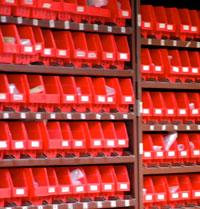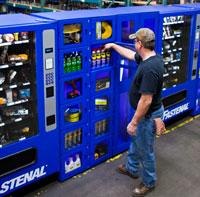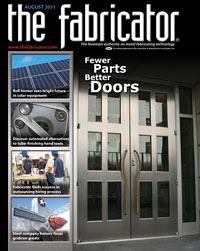Editor-in-Chief
- FMA
- The Fabricator
- FABTECH
- Canadian Metalworking
Categories
- Additive Manufacturing
- Aluminum Welding
- Arc Welding
- Assembly and Joining
- Automation and Robotics
- Bending and Forming
- Consumables
- Cutting and Weld Prep
- Electric Vehicles
- En Español
- Finishing
- Hydroforming
- Laser Cutting
- Laser Welding
- Machining
- Manufacturing Software
- Materials Handling
- Metals/Materials
- Oxyfuel Cutting
- Plasma Cutting
- Power Tools
- Punching and Other Holemaking
- Roll Forming
- Safety
- Sawing
- Shearing
- Shop Management
- Testing and Measuring
- Tube and Pipe Fabrication
- Tube and Pipe Production
- Waterjet Cutting
Industry Directory
Webcasts
Podcasts
FAB 40
Advertise
Subscribe
Account Login
Search
Streamlining the purchasing job
Following a few tips can eliminate a lot of the pain associated with material requisitioning
- By Dan Davis
- August 1, 2011
- Article
- Shop Management

Figure 1: As part of lean manufacturing techniques, just enough inventory is kept near assembly areas to accommodate manufacturing for a certain duration. Some metal fabricators elect to outsource inventory replenishment to third parties, allowing them to concentrate on core manufacturing activities.
Jeremy Riniker doesn’t have to boast about his talents because his title sums them up nicely: buyer/estimator/designer.
Of course, that doesn’t come as a surprise to metal fabricators. Multiple skill sets are pretty much required for any successful employee in a modern manufacturing environment.
Riniker has worked for Giese Manufacturing, Dubuque, Iowa, for about 18 months. He is a graduate of the University of Wisconsin-Platteville with a degree in industrial technology who also minored in 3-D drafting and new-product development. He’s jumped right into working with the company’s SolidWorks® 3-D CAD modeling software, but the other duties are somewhat new to him. The new duties of purchasing and estimating, however, help to keep each day fresh and exciting, according to Riniker. He doesn’t know what to expect when he walks through the door each morning, and that provides an exciting challenge.
Even though he may be inexperienced, Riniker does have opinions, and some of them have helped to improve shop floor productivity and streamline purchasing. Sometimes a new point of view is just what an organization needs.
Tip No. 1: Take Time to Meet With Vendors
Riniker said that when he assumed his buying duties, he soon became inundated with calls and visits from vendors hawking their latest products and services. He laughingly said that meeting with these folks could have been a full-time job, which is not possible when you have other duties, but he did realize that it might behoove him to meet with some of these vendors. After all, it would allow him to see what metal fabricating technologies might make good additions to Giese Manufacturing’s shop floor.
“The only way we know what’s out there is to listen,” Riniker said.
So he made a commitment to carve out time in his schedule to meet with those vendors that had promising information to share. That newfound commitment paid off almost immediately after his meeting with a sales representative selling a new, more durable ceramic abrasive disc for grinding. Giese Manufacturing’s grinders had been going through 10 to 20 traditional hook-and-loop abrasive discs per day, but now use only one of the new ceramic abrasive discs per day because the grinding surface doesn’t deteriorate as quickly. As a result, the grinding operators don’t have to seek out new grinding discs several times per day, and more parts are being processed.
Obviously, Riniker can’t meet with these sales reps each and every day, but he makes a note to set aside time, realizing that he might be exposed to money-saving production technology that can make a real difference on the shop floor and the bottom line.
Tip No. 2: Create Templates for Purchasing Orders
When juggling multiple responsibilities, a person quickly looks to see what can be changed to save some time. Soon into his purchasing role Riniker learned he didn’t care for filling out requisition forms—particularly those that involved ordering the same items over and over again. That led him to create templates.
Now he quickly plugs in a limited amount of information, such as quantity, on these tailored requisition forms and kicks them out to vendors in a quick manner. The vendors receive all of the necessary information and turn the orders around in the agreed-upon time frame.

Figure 2: Using vending machines for consumables and safety gear is growing in popularity because replenishment ordering is automated, stockouts are less likely to occur, and operators don’t get tied up searching an unorganized tool crib for parts.
Of course, because the templates are computer-generated, he can update them as necessary.
Tip No. 3: Consider a Replenishment Partner
Riniker didn’t come up with the idea of reaching out to an inventory replenishment partner, but he can vouch for the idea’s effectiveness in terms of helping him to take on multiple job assignments.
“I’m pretty close to capacity,” Riniker said.
Fastenal is Giese Manufacturing’s inventory replenishment partner. It has been restocking bins (see Figure 1) near the company’s assembly area for a little over three years now.
“They actually check the bins every time they are over here [Tuesdays and Thursdays]. They double-check what we need, or if our shop guys check out the bins and see that they are low, they will let me know,” Riniker said.
Mark Edminster, general manager for Fastenal’s Dubuque store, is more direct in describing his company’s relationship with Giese Manufacturing: “I’ve been doing it for them for so long that it’s routine. I know what they use and what they don’t use.”
That close relationship actually made it easy for Fastenal to suggest installing its FAST 5000SM vending machine (see Figure 2) just before Riniker began working at Giese Manufacturing. The vending machine is able to provide the company with data on its inventory usage that it was never really able to pull together easily.
“With our vending machine, there is real-time information that’s tied into a computer line. Fastenal actually pulls up a computer screen and sees what our vending machine has in stock,” Riniker said.
“I get a report every day of what they go through and what they don’t go through,” Edminster added.
The unit requires 110-V power and an Ethernet connection. Its operating system is in the controller board, and all communication with the vending machine is outbound only—meaning that other devices cannot establish a direct connection to it.
Currently Giese Manufacturing keeps personal safety gear and high-usage consumables, such as cutting tools and grinding discs, in the machine. The information reports are important in keeping the right mix of products stocked. The Fastenal representative can remove those items that are less commonly used, such as cutting oil fluid containers, and increase the availability of consumables always in demand. The representative also can watch for patterns, such as a spike in the number of grinding discs used, and notify its customer of a potential problem on the shop floor.
In the end, these tips can be helpful in providing more time for other activities. As Riniker can tell you, time is not something you can purchase from a vendor.
About the Author

Dan Davis
2135 Point Blvd.
Elgin, IL 60123
815-227-8281
Dan Davis is editor-in-chief of The Fabricator, the industry's most widely circulated metal fabricating magazine, and its sister publications, The Tube & Pipe Journal and The Welder. He has been with the publications since April 2002.
Related Companies
subscribe now

The Fabricator is North America's leading magazine for the metal forming and fabricating industry. The magazine delivers the news, technical articles, and case histories that enable fabricators to do their jobs more efficiently. The Fabricator has served the industry since 1970.
start your free subscription- Stay connected from anywhere

Easily access valuable industry resources now with full access to the digital edition of The Fabricator.

Easily access valuable industry resources now with full access to the digital edition of The Welder.

Easily access valuable industry resources now with full access to the digital edition of The Tube and Pipe Journal.
- Podcasting
- Podcast:
- The Fabricator Podcast
- Published:
- 04/16/2024
- Running Time:
- 63:29
In this episode of The Fabricator Podcast, Caleb Chamberlain, co-founder and CEO of OSH Cut, discusses his company’s...
- Trending Articles
AI, machine learning, and the future of metal fabrication

Employee ownership: The best way to ensure engagement

Steel industry reacts to Nucor’s new weekly published HRC price

Dynamic Metal blossoms with each passing year

Metal fabrication management: A guide for new supervisors

- Industry Events
16th Annual Safety Conference
- April 30 - May 1, 2024
- Elgin,
Pipe and Tube Conference
- May 21 - 22, 2024
- Omaha, NE
World-Class Roll Forming Workshop
- June 5 - 6, 2024
- Louisville, KY
Advanced Laser Application Workshop
- June 25 - 27, 2024
- Novi, MI


























